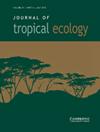Environmental correlates of some selected fish species in the Jebba Dam, North-Central Nigeria
IF 1
4区 环境科学与生态学
Q4 ECOLOGY
引用次数: 0
Abstract
There is a lack of comprehensive understanding of environmental factors influencing fish species’ abundance and distribution in some Nigerian freshwater ecosystems. Our study investigated the environmental factors that drive the abundance and distribution of three economically important fishes – Lates niloticus, Citharinus citharus, and Distichondus rostratus – in Jebba Hydroelectric power dam in Northcentral Nigeria. The species catch abundance was determined using gillnets of different mesh sizes, each measuring 50 m length and 20 m deep. The physicochemical parameters were also assessed following standard methods. A total relative abundance of 47.49%, 27.74%, 24.77% were observed for C. citharus, L. niloticus, and D. rostratus, respectively. The canonical correspondence analysis showed that the catch abundance of L. niloticus associates with water volume, turbidity, phosphate, and hydrogen carbonate. Analysis showed that water hardness, biological oxygen demand (BOD), dissolved oxygen (DO), and chloride levels drive the catch abundance of D. rostratus, while C. citharus associates with temperature and depth. The linear Pearson correlation showed a strong positive relationship of the abundance of L. niloticus with turbidity, phosphate, total suspended solids, hydrogen carbonate, water depth, temperature, and water volume. Our result showed a strong positive association of the abundance of C. citharus with water volume, total dissolved solids, temperature, and water depth. A strong positive relationship of the abundance of D. rostratus with conductivity, water depth, and total dissolved solids was reported. Our study improved knowledge on the environmental factors affecting the abundance of three economically important freshwater fishes in Jebba Hydroelectric dam. Further study is needed to investigate the impact of global climate change on the future distribution of these freshwater fish species.尼日利亚中北部杰巴大坝某些选定鱼类的环境相关性
对尼日利亚一些淡水生态系统中影响鱼类丰度和分布的环境因素缺乏全面的了解。我们的研究调查了尼日利亚中北部杰巴水电站大坝中三种经济上重要鱼类——尼罗河Lates niloticus、Citharinus和Distichondus rostratus——丰度和分布的环境因素。使用不同网目大小的刺网测定物种捕获量,每个刺网长50米,深20米。理化参数也按照标准方法进行评估。C.citharus、L.niloticus和D.rostratus的总相对丰度分别为47.49%、27.74%和24.77%。典型对应分析表明,尼罗罗非鱼的渔获物丰度与水量、浊度、磷酸盐和碳酸氢盐有关。分析表明,水硬度、生物需氧量(BOD)、溶解氧(DO)和氯离子水平驱动着罗汉藻的渔获物丰度,而罗汉藻则与温度和深度有关。线性Pearson相关表明,尼罗菌的丰度与浊度、磷酸盐、总悬浮物、碳酸氢盐、水深、温度和水量呈正相关。我们的结果表明,C.citharus的丰度与水量、总溶解固体、温度和水深呈正相关。据报道,D.rostratus的丰度与电导率、水深和总溶解固体呈正相关。我们的研究提高了对影响杰巴水电站大坝三种重要经济淡水鱼类丰度的环境因素的认识。需要进一步研究全球气候变化对这些淡水鱼类未来分布的影响。
本文章由计算机程序翻译,如有差异,请以英文原文为准。
求助全文
约1分钟内获得全文
求助全文
来源期刊

Journal of Tropical Ecology
环境科学-生态学
CiteScore
2.10
自引率
0.00%
发文量
44
审稿时长
18-36 weeks
期刊介绍:
Journal of Tropical Ecology aims to address topics of general relevance and significance to tropical ecology. This includes sub-disciplines of ecology, such as conservation biology, evolutionary ecology, marine ecology, microbial ecology, molecular ecology, quantitative ecology, etc. Studies in the field of tropical medicine, specifically where it involves ecological surroundings (e.g., zoonotic or vector-borne disease ecology), are also suitable. We also welcome methods papers, provided that the techniques are well-described and are of broad general utility.
Please keep in mind that studies focused on specific geographic regions or on particular taxa will be better suited to more specialist journals. In order to help the editors make their decision, in your cover letter please address the specific hypothesis your study addresses, and how the results will interest the broad field of tropical ecology. While we will consider purely descriptive studies of outstanding general interest, the case for them should be made in the cover letter.
 求助内容:
求助内容: 应助结果提醒方式:
应助结果提醒方式:


